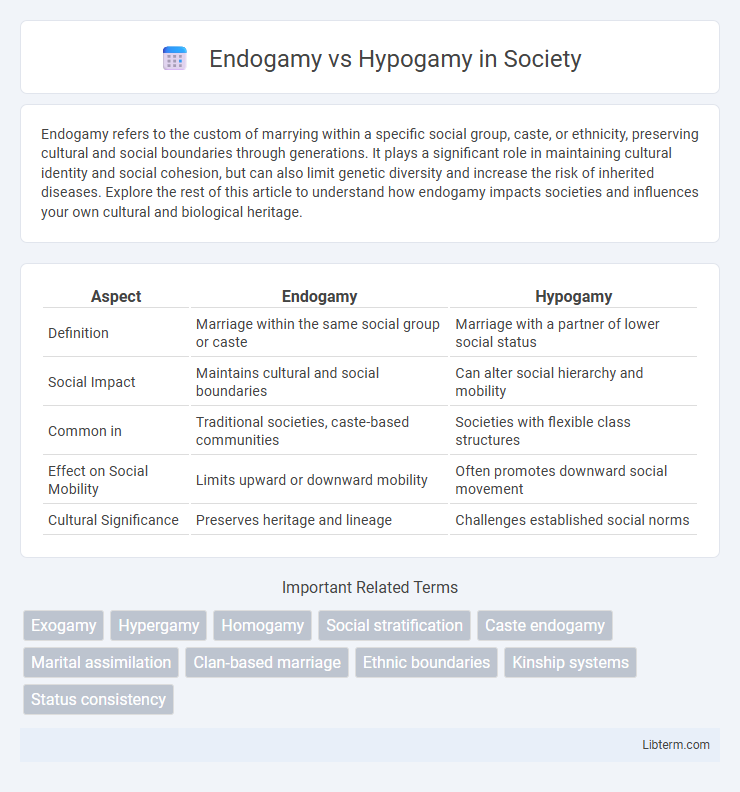Endogamy refers to the custom of marrying within a specific social group, caste, or ethnicity, preserving cultural and social boundaries through generations. It plays a significant role in maintaining cultural identity and social cohesion, but can also limit genetic diversity and increase the risk of inherited diseases. Explore the rest of this article to understand how endogamy impacts societies and influences your own cultural and biological heritage.
Table of Comparison
| Aspect | Endogamy | Hypogamy |
|---|---|---|
| Definition | Marriage within the same social group or caste | Marriage with a partner of lower social status |
| Social Impact | Maintains cultural and social boundaries | Can alter social hierarchy and mobility |
| Common in | Traditional societies, caste-based communities | Societies with flexible class structures |
| Effect on Social Mobility | Limits upward or downward mobility | Often promotes downward social movement |
| Cultural Significance | Preserves heritage and lineage | Challenges established social norms |
Understanding Endogamy: Definition and Origins
Endogamy refers to the social practice of marrying within a specific group, caste, or community to preserve cultural or social homogeneity. Its origins can be traced back to ancient societies where maintaining lineage, property, and social status was crucial. This practice reinforces group identity and cohesion by limiting external alliances and strengthening internal bonds.
What is Hypogamy? A Clear Explanation
Hypogamy is a social practice where an individual marries someone of lower socioeconomic status or caste, often reversing traditional patterns of endogamy that emphasize marrying within the same social group. This phenomenon challenges conventional norms and can influence social mobility, family dynamics, and cultural perceptions. Understanding hypogamy requires analyzing its impact on social hierarchy and the factors motivating individuals to marry outside or below their status group.
Key Differences Between Endogamy and Hypogamy
Endogamy refers to the practice of marrying within a specific social, ethnic, or cultural group, ensuring the preservation of group identity and social cohesion. Hypogamy involves marrying someone of a lower social or economic status, often reflecting social mobility or strategic alliances. Key differences include the focus of endogamy on group boundaries versus hypogamy's emphasis on social hierarchy and status disparities in marital choices.
Historical Contexts: Endogamy and Social Structures
Endogamy, the practice of marrying within a specific social group, caste, or ethnicity, has historically reinforced social structures by limiting group boundaries and preserving cultural identity. In many traditional societies, endogamous marriage served to maintain caste hierarchies, sustain wealth within family lines, and uphold religious or ethnic purity. This form of marriage created social stratification by restricting social mobility and reinforcing communal cohesion through shared heritage.
Hypogamy in Modern Societies: Trends and Examples
Hypogamy, the practice of marrying into a lower socioeconomic status, shows evolving trends in modern societies where increased social mobility challenges traditional marriage patterns. Studies reveal growing acceptance of hypogamous unions in urban areas, especially among women pursuing higher education and career advancement. Examples from countries like the United States and Sweden highlight shifting cultural norms that support marital choices based on personal compatibility rather than strict socioeconomic hierarchies.
Cultural Influences on Marriage Patterns
Endogamy, the practice of marrying within a specific social group, caste, or ethnicity, often reflects cultural preservation and social cohesion, especially in traditional societies. Hypogamy, marrying into a lower social or economic status, is shaped by cultural norms and economic factors, commonly observed in societies with rigid class structures or gender roles. Both marriage patterns are deeply influenced by cultural beliefs, religious doctrines, and community expectations that dictate acceptable spouse selection and reinforce societal hierarchies.
Societal Impacts of Endogamy and Hypogamy
Endogamy fosters social cohesion within specific groups by encouraging marriage among similar cultural, religious, or ethnic communities, thereby preserving traditions and limiting social diversity. Hypogamy--marrying into a lower social class--can lead to shifts in social mobility patterns, often challenging established hierarchies and potentially reducing socioeconomic disparities over time. Both endogamy and hypogamy significantly influence societal structures by shaping community boundaries, impacting cultural integration, and affecting the distribution of resources and power.
Endogamy, Hypogamy, and Gender Roles
Endogamy refers to the practice of marrying within a specific social group, caste, or ethnicity, reinforcing existing social structures and cultural continuity. Hypogamy involves marrying into a group of lower social status, which often intersects with traditional gender roles where women marry "down" in status, reflecting societal expectations of gender and class dynamics. Both endogamy and hypogamy are influenced by deeply entrenched gender roles that shape marital choices, social stratification, and power relations within communities.
Challenges and Criticisms of Endogamous and Hypogamous Marriages
Endogamous marriages often face challenges related to genetic diversity and social isolation, increasing risks of inherited disorders and limiting exposure to broader cultural perspectives. Hypogamous marriages encounter criticisms tied to social stigma and economic disparities, where partners with lower social status may face prejudice or reduced familial support. Both marriage types can experience tensions rooted in societal norms and evolving expectations regarding equality and social mobility.
The Future of Marriage: Shifting Patterns and Perspectives
Endogamy, the practice of marrying within a specific social or cultural group, contrasts with hypogamy, where individuals marry into a lower socioeconomic status. Shifting patterns in marriage reveal growing acceptance of diverse relationships, influenced by globalization and changing societal values. Future marriage perspectives emphasize fluidity in social boundaries and rising preference for individual compatibility over traditional norms.
Endogamy Infographic

 libterm.com
libterm.com